The device and operation of different optical devices are based on the principles of geometrical optics. Let’s examine a few of them.
An opaque camera and a lens system called a lens are the main components of a camera. The most basic lens is a single collecting lens. This lens forms a real inverted image of the subject being photographed close to the rear of the camera (Fig. 7.61).
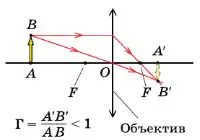
Typically, the object is situated at a distance that is greater than twice the focal length, resulting in a decrease in the size of the image. In the past, a photographic plate or film coated with a photosensitive substance (photoemulsion) would be placed at the location where the image is formed. In modern digital cameras, this film is replaced by an array of photosensitive elements (photodiodes) embedded on an integrated circuit. The incident light on these photodiodes is converted into an electrical signal.
The object to be captured in a photograph may be at varying distances from the camera. As a result, the distance between the lens and the film or sensor must be adjusted accordingly. This adjustment is typically achieved by moving the lens.
The camera captures the subject’s image as an actual, inverted, and reduced image.
Projection apparatus.
Figure 7.62 illustrates a schematic diagram of a projection apparatus.
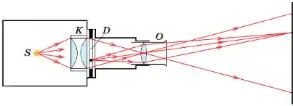
The screen displays an image of a diapositive 1 D by utilizing a lens О. A condenser lens system К is employed to ensure that all of the light emitted from the slide passes through the lens. The lens then projects the illuminated slide onto the screen.
1 A slide refers to a transparent base on which a drawing or photograph is produced.
The projection apparatus can adjust its magnification by moving the lens closer or farther from the slide while also adjusting the distance between the apparatus and the screen. It should be noted that the subject in the projection apparatus needs to be positioned at distances ranging from F to 2F (as shown in Fig. 7.63). The magnification of the projection apparatus increases as the focal length of the lens decreases.
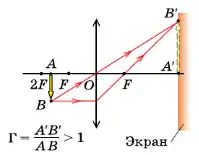
The projection apparatus produces an actual, enlarged, and inverted image of an object.
Optical devices that assist the eye can be classified into two categories based on their purpose:
1) Devices for magnifying small objects (such as magnifiers and microscopes).
2) Devices for observing distant objects (such as telescopes).
Unlike cameras and projection apparatus, these devices create virtual images of the objects being observed.
The angular magnification of an optical device, which is the ratio of the viewing angle through the device to the naked eye, serves as a characteristic of the device.
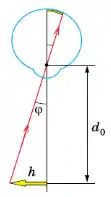
The naked eye can observe an object at an angle of view (Fig. 7.64) that is equal to 2
2 For small angles.
Where d0 = 25 cm represents the optimal viewing distance; h – the linear size of the object.
To enhance the angle of view for small objects, the simplest method is to utilize a magnifying glass. The magnifier consists of a converging lens or a set of lenses with a small focal length F (typically not exceeding 10 cm). The magnifier is typically positioned close to the eye, with the object placed in its focal plane. As a result, the rays from any point of the object, upon leaving the magnifying glass, form parallel beams (Fig. 7.65).

As a result, the eye is not strained when obtaining a clear image of points on the retina. The magnifying glass allows the object to be viewed from an angle.
By dividing equation (2) by equation (1), we can determine the angular magnification of the magnifier, denoted as Гл:
The magnification provided by the magnifier is limited by its size. A lens with a high optical power needs to be strongly convex, which means the size of the magnifier must be reduced to just a few millimeters. This limitation affects the field of view and makes using the magnifier more challenging. Therefore, magnifiers with magnification exceeding 40 are not commonly used. These magnifiers find applications among watchmakers, geologists, botanists, forensic scientists, stamp collectors, and individuals engaged in precise and delicate work and measurements.
The combination of two lenses or lens systems (Fig. 7.66) is what makes a microscope. The lens L1 that faces the object is known as the objective lens. The magnified image of the object produced by this lens can be viewed through a magnifying glass L2 – the eyepiece. This results in a significant overall magnification.
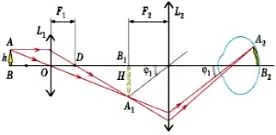
Let’s take a look at how a microscope works. In order to get a magnified image, we place the object AB between the focal point of the objective lens and a point located at twice the focal length. It’s more convenient to observe through the eyepiece without straining our eyes. To achieve this, we position the eyepiece so that the image A1B1 produced by the objective lens is in line with the focal plane of the eyepiece (refer to Fig. 7.66).
The magnification of the microscope, denoted as Гм, is defined as the ratio of the angle of view φ1 when observing an object through the microscope to the angle of view φ when observing the same object with the naked eye from the optimal viewing distance d0 = 25 cm:
Here, h represents the linear dimension of the object.
The eyepiece of the microscope functions as a magnifying glass, so
where H corresponds to the linear dimension of the image produced by the objective lens and F2 represents the focal length of the eyepiece.
The linear size of the image formed by the lens is connected to the linear size of the object by the following relation:
The optical length of the microscope tube is referred to as the magnification.
By substituting the values of angles (4) and (5) into expression (3) and considering relations (6) and (7), we derive the equation for microscope magnification:
The magnification of a microscope ranges from a few tens to 1500. It enables the observation of intricate details of an object that would otherwise appear merged to the naked eye or when using a magnifying glass.
A telescope is a device used for observing celestial bodies and stars. There are two types of telescopes: refractors and reflectors. A refractor telescope uses lenses to magnify distant objects in the visible range. To achieve maximum magnification, the image A1B1 of the distant object must be focused on the eyepiece F2 of the telescope. This requires the focal points of the objective and eyepiece to coincide (Fig. 7.67).
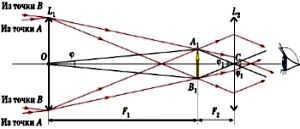
The magnification of the refractor telescope Gt is determined by the ratio of the viewing angle φ1 when observing a distant object through the telescope, to the viewing angle φ when observing with the naked eye.
Based on Figure 7.67, it can be demonstrated that
In a reflector telescope, the lens is a large parabolic mirror with a diameter of 6 meters. One of the biggest telescopes of this kind is the BTA (Big Telescope Azimuthal) located in the Caucasus foothills. There are now even larger telescopes with mirrors of greater sizes, such as the ones found in the Keck Observatory. Each of the two mirror telescopes in the observatory have three primary mirrors with a diameter of 10 meters.
The path of the rays in a reflecting telescope can be seen in Figure 7.68.
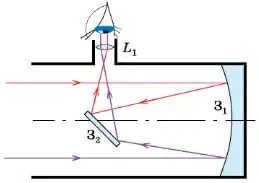
When light from a celestial body passes through the telescope, it forms a nearly parallel beam. This beam is then reflected by mirror 31 and converges in the focal plane. To view the image of the celestial body, the light rays are directed into the eyepiece L1 with the help of a flat mirror 32. The magnification of larger telescopes can exceed 500 due to their long focal length. By using a telescope, it becomes possible to observe objects on the Moon that are less than 1 meter in size, as well as objects on Mars that are about 100 meters in size.
1. Describe the picture of an object received with:
2. How can we classify the optical instruments that equip the eye?
3. What is the term for the angular magnification of an optical instrument?
4. What is the value of the angular magnification:
5. How can telescopes be divided into two categories based on their optical arrangement?
Discussion Questions:
Is it feasible to observe a fly landing on the lens of this telescope using another telescope?
Exercises:
1. Calculate the angular magnification of a magnifying glass with the following focal lengths:
2. Determine the optical power of a magnifier that provides:
a) 4x angular magnification;
b) 2-fold angular magnification.
3. Calculate the angular magnification of a magnifying glass with a focal length of 2 cm:
b) for a nearsighted eye with a distance of optimal vision of 15 cm.
4. What is the angular magnification of a telescope if the focal length of the objective lens is 15 m and the eyepiece is 2.5 cm?
A telescope is an extraordinary optical device created for observing celestial objects. These instruments enable us to explore a wide range of entities, not only those in close proximity but also those situated thousands of light years from Earth. Hence, what precisely is a telescope and who is its originator?

The Inventor Puzzle
The emergence of telescopic devices can be traced back to the seventeenth century. However, even after all these years, there is still an ongoing debate regarding the true inventor of the telescope – Galileo or Lippershey. The reason behind this debate lies in the fact that both scientists were simultaneously involved in the development of optical instruments.
In 1608, Lippershey came up with a remarkable invention – glasses that allowed nobles to observe distant objects with great clarity. This invention coincided with ongoing military negotiations, and it didn’t take long for the Army to recognize the value of Lippershey’s creation. They proposed that Lippershey forgo copyrighting the device and instead enhance it to enable binocular viewing. The scientist agreed to their proposal.
The scientist’s latest invention was impossible to keep under wraps: details about it were released in the local media. The press of that era referred to the invention as a telescope. It utilized a pair of lenses that enabled the magnification of objects and subjects. By 1609, in Paris, sales of tubes with a threefold magnification were booming. From that point onward, all records of Lippershey vanish from history, only to be replaced by information about a different scientist and his groundbreaking findings.

Galileo’s innovation: the telescope
During the same era, the Italian scientist Galileo was occupied with the process of grinding lenses. In the year 1609, he unveiled a groundbreaking invention to the world – a telescope that had the capability to magnify objects threefold. Galileo’s creation surpassed the image quality of Lippershey’s tubes, and it was fittingly given the name “telescope.”
In the 17th century, Dutch scientists were responsible for creating telescopes, but their image quality was subpar. It was only Galileo who managed to refine the technique of lens grinding, resulting in a significant improvement in object clarity. He achieved a twentyfold increase, which was a groundbreaking advancement in science at the time. This raises the question of who truly invented the telescope: according to the official version, Galileo introduced the world to the device, which he named a telescope. However, if we consider the development of an optical device for magnifying objects, the credit goes to Lippershey as the first innovator.
The initial observations of the sky
Following the introduction of the first telescope, groundbreaking discoveries were made. Galileo utilized its advancement to observe celestial entities. He was the pioneer in witnessing and depicting lunar craters, sunspots, and the stars within the Milky Way, as well as the satellites revolving around Jupiter. Galileo’s telescope even allowed for the observation of the rings encircling Saturn. Interestingly, there remains a telescope in existence today that operates on the same principles as Galileo’s apparatus. This particular telescope is situated at the York Observatory, boasting a diameter of 102 centimeters and effectively aiding scientists in their celestial tracking endeavors.
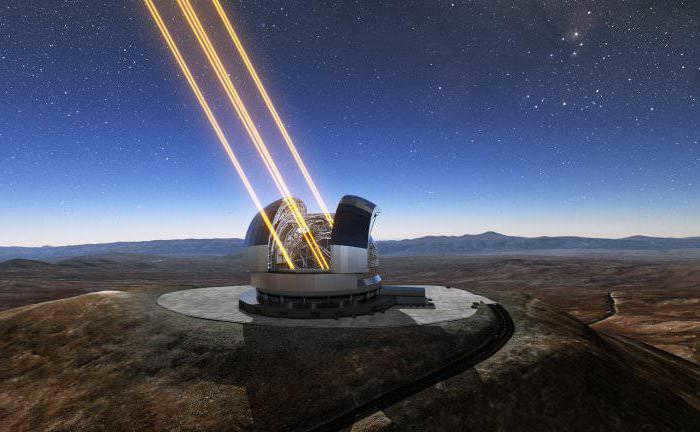
Contemporary telescopes
Throughout the ages, scientists have continuously modified the designs of telescopes, creating new models and enhancing their magnification. Consequently, a range of small and large telescopes with varying purposes have been developed.
The smaller ones are typically used for observing space objects from home, as well as studying nearby cosmic entities. On the other hand, larger instruments enable the viewing and capturing of celestial bodies located thousands of light years away from Earth.
There are various types of telescopes:
Galileo refractors are categorized as lenticular telescopes. Reflectors, on the other hand, are classified as mirror telescopes. What is a catadioptric telescope? It is a modern and innovative design that combines both lenticular and mirror elements.
Lens-based telescopes
Telescopes play a significant role in astronomy as they enable the observation of comets, planets, stars, and other celestial objects. Some of the earliest telescope designs were based on lenses.
Every telescope contains a lens, which is its primary component. The lens refracts light rays and focuses them at a specific point called the focus. The image of the observed object is constructed at this point. An eyepiece is used to examine the resulting image.
The placement of the lens is arranged so that the eyepiece and the focal point align. In contemporary designs, telescopes are equipped with adjustable eyepieces to facilitate observation. This feature allows for fine-tuning the image sharpness.
Every telescope exhibits some form of aberration, which results in distortion of the observed object. Lens-based telescopes are susceptible to two types of distortion: chromatic aberration (where red and blue rays are distorted) and spherical aberration.

Types of Reflectors
Reflecting telescopes are also known as mirror telescopes. They utilize a spherical mirror to collect and reflect light to the eyepiece. Unlike refracting telescopes, reflectors do not suffer from chromatic aberration because light is not refracted. However, reflector models often experience spherical aberration, which can limit the field of view.
Advanced reflector telescopes employ intricate designs and mirrors with non-spherical surfaces.
Although mirror models are easier to develop than lenticular ones, they still have a complex design. As a result, mirror telescopes are more commonly used. The largest mirror telescope has a diameter of over seventeen meters, with the largest one in Russia measuring six meters in diameter. For a long time, this Russian telescope held the title of the largest in the world.
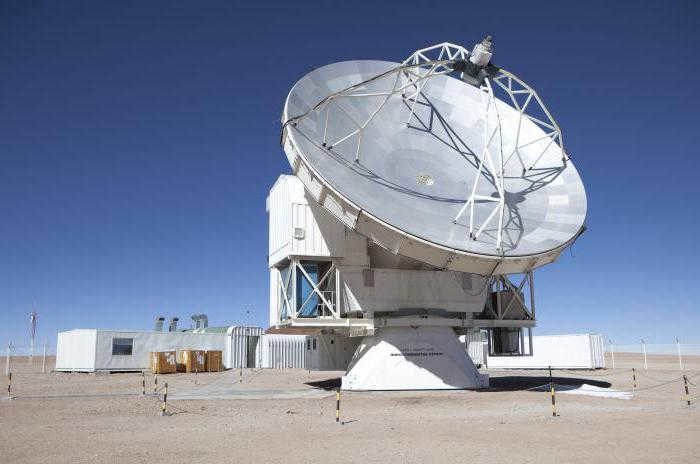
Telescope Characteristics
Many individuals purchase optical devices for the purpose of observing celestial bodies. When selecting a device, it is essential to have knowledge not only of what a telescope is, but also of its various characteristics.
- Magnification. The magnification of a telescope is determined by the focal length of the eyepiece and the object being observed. For instance, if the lens has a focal length of two meters and the eyepiece has a focal length of five centimeters, the telescope will have a magnification of forty times. However, if the eyepiece is changed, the magnification will be different.
Uniquely Phrased: Telescopes with No Visual Perception
What purpose does a telescope serve if it lacks the ability to see? It is a known fact that each person’s visual perception differs. One eye may perceive more, while the other may perceive less. To ensure that scientists are able to observe everything they need to see, telescopes without visual perception are utilized. These devices transmit the image onto monitor screens, allowing everyone to view the image exactly as it is without any distortions. For smaller telescopes, cameras have been developed to fulfill this purpose. These cameras are connected to the instruments and capture images of the sky.
The use of CCD cameras has revolutionized the way we observe space. These advanced light-sensitive chips collect data from telescopes and transmit it to computers, providing incredibly clear and detailed images. It’s hard to imagine any other devices that could capture such high-quality information. In fact, the human eye can’t even perceive all the subtle nuances that modern cameras can.
When it comes to measuring distances between stars and other celestial objects, scientists rely on spectrographs. These specialized devices are seamlessly integrated with telescopes, allowing for precise measurements and analysis.
A contemporary astronomical telescope is not just one apparatus, but multiple devices combined. The information gathered from these various devices is then processed and presented on screens as visual representations. As a result of this processing, scientists are able to obtain images of incredibly high resolution. It is unattainable to witness the same level of clarity and detail of celestial bodies with the naked eye through a telescope.

Types of Optical Telescopes
Astronomers utilize massive radio telescopes to advance their scientific research. Typically, these telescopes resemble large metal bowls with a parabolic design. The antennas gather and interpret received signals, converting them into visual representations. Radio telescopes are capable of detecting only a single wave of signals.
An excellent illustration of an infrared telescope is the Hubble device, even though it has the capability to be optical as well. In numerous aspects, the structure of infrared telescopes mirrors that of optical mirror models. The thermal rays are reflected by a traditional telescopic lens and concentrated at a specific point where the thermal measuring device is positioned. The resultant thermal rays are then filtered through thermal filters. It is only after this process that the photograph is captured.
Telescopes for Detecting Ultraviolet Light
When capturing photographs, ultraviolet rays can be used to illuminate the photographic film. In certain sections of the ultraviolet spectrum, it is possible to capture images without the need for additional processing or backlighting. However, in other instances, it is necessary for the light rays to pass through a specially designed filter. The utilization of these filters aids in isolating the radiation from specific areas.

There exist various types of telescopes, each with its own specific purpose and unique characteristics. These include X-ray and gamma-ray telescopes, which serve different functions. Additionally, telescopes can be classified as either amateur or professional, based on their intended use. However, this is just a partial classification of devices used for observing celestial bodies.
A magnifier is a type of lens with a short focal length. The angular magnification is determined by the ratio of the observed angle with the optical instrument to the angle visible to the naked eye at the distance of optimal vision.

2. What are the components of a microscope and how do the objective and eyepiece function?
A microscope is composed of two lenses with short focal lengths – the eyepiece (the lens nearest to the observer’s eye) and the objective (the lens nearest to the object). The objective is responsible for magnifying the image, while the eyepiece acts as a magnifying glass.

It ranges from 15 to 1200.
The objective lens generates an enlarged representation of an item in front of the eyepiece, then the eyepiece magnifies that representation. (Fig. 222 b of the textbook.)
4 What components compose a refractor telescope? Clarify the function of the objective and eyepiece.
A refractor telescope consists of an objective lens and an eyepiece.
The eyepiece acts as a magnifying lens, delivering angular magnification of the object. The focal points of the lens and eyepiece are practically indistinguishable. The eyepiece generates a direct, virtual, enlarged representation.
5. Describe the path of rays in a refractor telescope. Provide a formula for calculating the angular magnification of a refractor telescope. What are the constraints of using such telescopes?

An eyepiece is responsible for providing angular magnification of an object. It is worth noting that the focal points of both the objective and eyepiece are almost identical. As a result, the eyepiece is able to create a direct and magnified image that exists only in the imagination.
However, it is important to acknowledge that the use of eyepieces is somewhat limited. This is due to their tendency to deform under the weight of their own structure and their tendency to absorb a significant amount of light. Additionally, the eyepiece is constrained by the minimum angle of vision of the human eye.
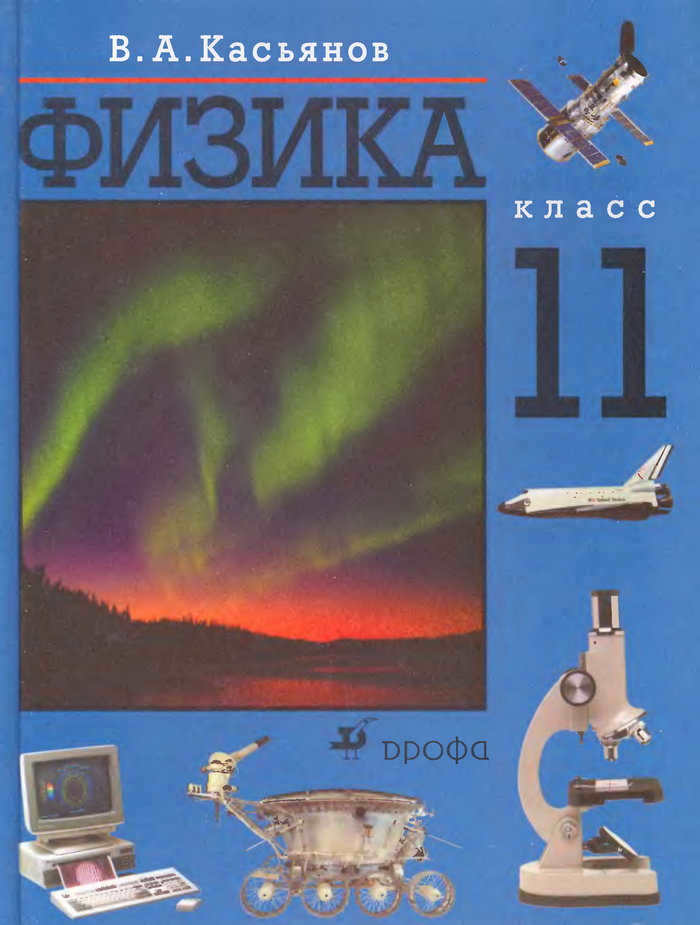
Physics assignment for 11th grade (Kasyanov V.A., 2002),
problem №71
from the chapter "Geometrical optics. § 67. Optical devices that enhance the field of view».
Summary of physics for 9th grade “Optical devices”. Construction and operating principle of a magnifying glass, optical microscope, optical telescope, camera lens.
Optical devices are tools created for capturing images of different objects. There are various optical instruments that assist the human eye. Some of these enable the viewer to perceive faraway objects (such as binoculars and telescopes), while others are designed for examining tiny objects (like magnifying glasses and microscopes). Optical devices also encompass technical tools that produce images on screens, photosensitive plates, photographic films, and other mediums positioned in the image plane. Examples of such devices include cameras and projection devices.
THE CONCEPT AND FUNCTIONING PRINCIPLE OF A MAGNIFYING GLASS
Let’s explore a basic optical instrument – the magnifying glass which comprises of a converging lens with a relatively short focal length (approximately 10 cm). The magnifying glass allows for the enlargement of images by a factor of 2 to 25. During usage, the magnifying glass is grasped by its handle and brought into close proximity to the eye, while the object of interest is positioned at a distance that ensures a clearer image.
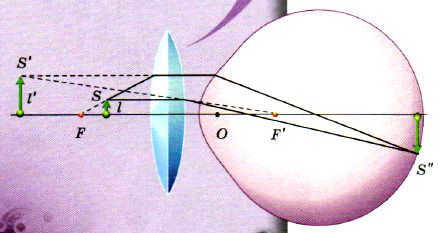
A loupe has various applications in different industries and settings, including biology, medicine, and more. For instance, watchmakers, jewelers, researchers, teachers, and even some doctors use table magnifiers for their work.
So, how does a magnifying glass create an image of an object? The distance between the loupe and the object being observed should be slightly shorter than the focal length. This results in an enlarged, direct, and virtual image of the object.
Let’s examine the path of light when observing a small object through a magnifying lens. Let F and F' be the focal points of the lens, and let O be the optical center of the eye. The virtual image of the object point S, denoted as Iobtained, is formed after the rays pass through the magnifying lens. We can denote this image as S'. The resulting image is denoted as l'. In this scenario, the rays from point S are first refracted by the magnifying lens, then by the refractive media of the eye, and finally converge at point S" on the retina. If there were no magnifying lens and the object itself were at point S' with the same size as l', the rays would still converge at point S".
The dotted line represents rays that are not physically present, as the virtual image formed by these rays does not emit or reflect light. The perception of seeing an object l' occurs because the eye naturally reconstructs the path of the incident rays, and after refraction by the magnifying glass, these rays converge on the eye, creating the illusion of a real object.
OPTICAL MICROSCOPE: DEVICE AND PRINCIPLE OF OPERATION
Frequently, the magnification of a simple magnifier is not sufficient. For achieving a high magnification of small objects, a system comprising of two or more lenses is utilized. These lens systems are employed in devices known as optical microscopes.
An optical microscope’s optical system is comprised of two components: the objective lens (facing the object) and the eyepiece (facing the eye). The objective lens, which is a small lens, brings the specimen closer, providing an actual, inverted, and magnified image of the object. This intermediate image is observed by the eye through the eyepiece, which functions similar to a magnifying glass.
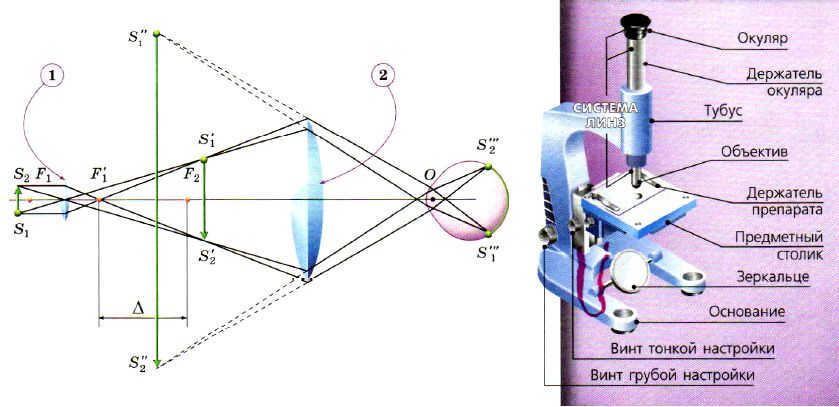
In front of the objective 1 of the microscope, a small object S1S2 is positioned at a distance slightly greater than the focal length of the objective, F1. When the light rays pass through the objective lens, they form an actual image S1'S2' between the eyepiece 2 and its front focus, F2. This image is then observed by the eye through the eyepiece, appearing as if it is magnified and coming from the imaginary, enlarged image S1"S2”.
The identity of the first inventor of the microscope remains a mystery. However, it is widely believed that in the late 16th century, two hereditary opticians named Zachary and Hans Jansen from the Netherlands were the first to combine two convex lenses inside a single tube, effectively creating the very first microscope. In 1609, Galileo Galilei further advanced the field by developing a compound microscope with both convex and concave lenses. However, it was Anthony van Leeuwenhoek (1632-1723) who is credited with introducing the microscope to the world of biology. His microscopes were small devices equipped with a single powerful lens.
The magnification power of a microscope far surpasses that of a single lens or eyepiece. It is determined by multiplying the magnification of the objective lens with the magnification of the eyepiece. As a result, microscopes with magnification levels of around 1000x or even higher are commonly employed in various scientific fields.
Microscopes play an essential role in various areas of human exploration, including medicine, biology, electronics, and geology. They are crucial tools for conducting research that leads to scientific breakthroughs, determining diagnoses, and developing new medications.
TELESCOPES
Optical Instruments for Observing Distant ObjectsTelescopes, also known as telescopes, are specifically designed for the purpose of observing objects that are far away. Similar to microscopes, they consist of two lenses – an objective lens with a large focal length that faces the object, and an eyepiece lens with a smaller focal length that faces the observer. In telescopes, the arrangement of the lenses ensures that the back focus of the objective lens, denoted as F1, nearly aligns with the front focus of the eyepiece lens, denoted as F2. The objective lens produces an actual, reduced, and inverted image of an object that is located infinitely far away. This image is then viewed through the eyepiece lens, much like looking through a magnifying glass. It is important to note that the objective lens of a telescope is always a collecting lens, while the eyepiece lens can be either a collecting or a diffusing lens. Depending on the type of eyepiece used, telescopes can be classified as either Kepler telescopes or Galileo telescopes.
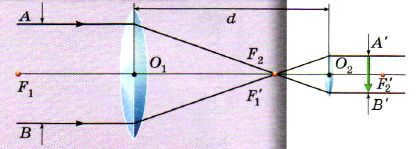
Contemporary telescopes have evolved into intricate and expansive structures with a multitude of components and mechanisms. The advancement of optical glass production, the refinement of grinding and polishing techniques for optical surfaces, and the overall progress in technology have all played a significant role in enhancing telescopes. Additionally, the discoveries made by optical scientists have contributed to these improvements. The invention of photography has also had a profound impact on astronomical research, leading to substantial changes in telescope design.
TELESCOPE BY KEPLER
Kepler’s tube is a type of telescope that has a collecting eyepiece. It is specifically designed for conducting astronomical observations. The images produced by Kepler’s telescope are actual, enlarged, and inverted, making it less suitable for terrestrial observations.
TELESCOPE BY GALILEO
A Galileo telescope, on the other hand, is equipped with a diffusing eyepiece. This type of telescope provides magnified and direct images, making it ideal for terrestrial observations.
CAMERA LENSES
The camera lens is an essential component of a device known as a camera. A camera is a tool that captures images of various objects by projecting them onto light-sensitive film or a digital plate. This process, known as photography, involves the lens projecting a real and reduced image onto a surface covered with a photosensitive layer. This image is necessary for the photosensitive composition to be affected properly. A collecting lens can achieve such an image if the object is located behind the lens’s double focus.
The fundamental principles of camera operation have remained mostly unchanged since the first camera was invented. However, modern digital cameras have become increasingly popular and have largely replaced film cameras, which were commonly used until the 1990s.
The initial photograph was captured in 1826 by a French engineer, Joseph Nicéphore Niépce. He uncovered a method to preserve the image by treating the glass surface with asphalt varnish to capture the light. In 1835, an English physicist named William Talbot, while studying Niépce’s camera, was able to enhance the quality of photographic images by inventing the negative print. George Eastman Kodak made his mark in the history of photography in 1889 with the patent for the first roll film and the subsequent invention of the Kodak camera specifically designed for photographic film. The Lumière brothers entered the scene in 1904 with their production of plates for color photography, laying the foundation for the future of color photography. Finally, in 1988, Fujifilm officially introduced the first digital camera.
In the latter half of the 1800s, initial endeavors were made to capture a dynamic image. The early film cameras boasted an array of lenses and shutters for high-speed shooting. The resulting prints were then inserted into a viewing apparatus, where they were scrolled, giving the impression of movement. Nowadays, we have devices known as motion picture and film projection equipment. Present-day films are typically shot at a rate of 24 frames per second, a pace that effectively conveys a seamless flow of motion.
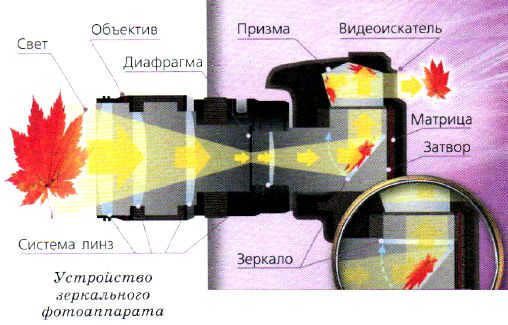
The primary component of a camera is the lens – an optical instrument or a system of optical instruments. It is inserted into the front portion of the light-tight enclosure of the camera. The lens has the capability to move smoothly in relation to the film in order to obtain a sharp representation of the subject. When a photograph is taken, a specialized shutter opens the lens, allowing the image to be captured on the photosensitive film – a medium that is responsive to light.
The physical structure of a contemporary digital camera consists of a box that is light-tight, and within this enclosure is the camera’s sensor. Furthermore, the body of the camera houses various control electronics, a viewfinder eye, and other essential components. Positioned on the body is the lens, which is a configuration comprised of a collection of lenses. One of the primary obstructions that light encounters on its path to the sensor is the shutter, which is a sophisticated technical apparatus that allows the light flux to reach the sensor when triggered.





